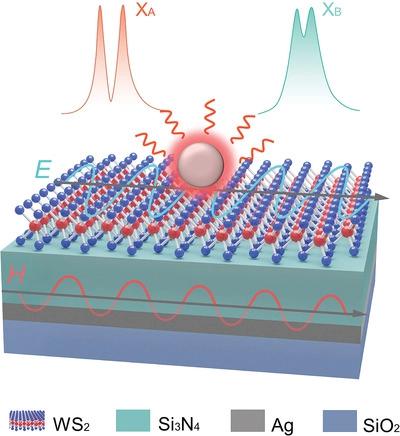当前位置:
X-MOL 学术
›
Laser Photonics Rev.
›
论文详情
Our official English website, www.x-mol.net, welcomes your
feedback! (Note: you will need to create a separate account there.)
Transverse-Electric-Polarized Polaritons Propagating in a WS2/Si3N4/Ag Heterostructure
Laser & Photonics Reviews ( IF 9.8 ) Pub Date : 2022-08-10 , DOI: 10.1002/lpor.202100457 Shulei Li 1, 2 , Lidan Zhou 1, 3 , Fu Deng 4 , Jin Xiang 5 , Mingcheng Panmai 1 , Hongxing Huang 1 , Guangcan Li 1 , Jingdong Chen 6 , Sheng Lan 1
Laser & Photonics Reviews ( IF 9.8 ) Pub Date : 2022-08-10 , DOI: 10.1002/lpor.202100457 Shulei Li 1, 2 , Lidan Zhou 1, 3 , Fu Deng 4 , Jin Xiang 5 , Mingcheng Panmai 1 , Hongxing Huang 1 , Guangcan Li 1 , Jingdong Chen 6 , Sheng Lan 1
Affiliation

|
Strong light–matter interaction has attracted great interest due to its potential applications in photonic and plasmonic devices. So far, many studies focus on micro- and nanocavities with three-dimensional confinement of light. Here, we investigate the coupling between the surface waves supported by a dielectric-metal heterostructure and the excitons in a two-dimensional material. It is revealed that the transverse-electric (TE) polarized waves excited in the dielectric-metal heterostructure possess significantly enhanced in-plane electric field on the surface of the dielectric layer. This unique property makes it possible to realize strong photon–exciton coupling with the excitons in a two-dimensional material. By using a tungsten disulfide (WS2)/silicon nitride (Si3N4)/silver (Ag) heterostructure, we demonstrate the strong coupling of the TE polarized waves with the two excitons (both A and B excitons) in the WS2 monolayer, creating TE polarized polaritons propagating in the heterostructure. The strong photon–exciton coupling is revealed in the angle-resolved reflection or scattering spectra with a Rabi splitting larger than the average damping rate of the TE polarized wave and the exciton. Our findings open new horizons for manipulating light–matter interaction in two-dimensional nanostructures and indicate the potential applications of such propagating polaritons in photonic and plasmonic devices.
中文翻译:

在 WS2/Si3N4/Ag 异质结构中传播的横向电极化极化激元
由于其在光子和等离子体器件中的潜在应用,强光-物质相互作用引起了极大的兴趣。到目前为止,许多研究都集中在具有三维光限制的微腔和纳米腔上。在这里,我们研究了介电金属异质结构支持的表面波与二维材料中的激子之间的耦合。结果表明,在介电金属异质结构中激发的横向电 (TE) 极化波在介电层表面具有显着增强的面内电场。这种独特的特性使得在二维材料中实现与激子的强光子-激子耦合成为可能。通过使用二硫化钨 (WS 2 )/氮化硅 (Si 3 N 4)/银 (Ag) 异质结构,我们证明了 TE 偏振波与 WS 2单层中的两个激子(A 和 B 激子)的强耦合,产生了在异质结构中传播的 TE 偏振激元。在角分辨反射或散射光谱中揭示了强光子-激子耦合,其中 Rabi 分裂大于 TE 偏振波和激子的平均阻尼率。我们的发现为在二维纳米结构中操纵光-物质相互作用开辟了新视野,并表明了这种传播极化激元在光子和等离子体器件中的潜在应用。
更新日期:2022-08-10
中文翻译:

在 WS2/Si3N4/Ag 异质结构中传播的横向电极化极化激元
由于其在光子和等离子体器件中的潜在应用,强光-物质相互作用引起了极大的兴趣。到目前为止,许多研究都集中在具有三维光限制的微腔和纳米腔上。在这里,我们研究了介电金属异质结构支持的表面波与二维材料中的激子之间的耦合。结果表明,在介电金属异质结构中激发的横向电 (TE) 极化波在介电层表面具有显着增强的面内电场。这种独特的特性使得在二维材料中实现与激子的强光子-激子耦合成为可能。通过使用二硫化钨 (WS 2 )/氮化硅 (Si 3 N 4)/银 (Ag) 异质结构,我们证明了 TE 偏振波与 WS 2单层中的两个激子(A 和 B 激子)的强耦合,产生了在异质结构中传播的 TE 偏振激元。在角分辨反射或散射光谱中揭示了强光子-激子耦合,其中 Rabi 分裂大于 TE 偏振波和激子的平均阻尼率。我们的发现为在二维纳米结构中操纵光-物质相互作用开辟了新视野,并表明了这种传播极化激元在光子和等离子体器件中的潜在应用。











































 京公网安备 11010802027423号
京公网安备 11010802027423号